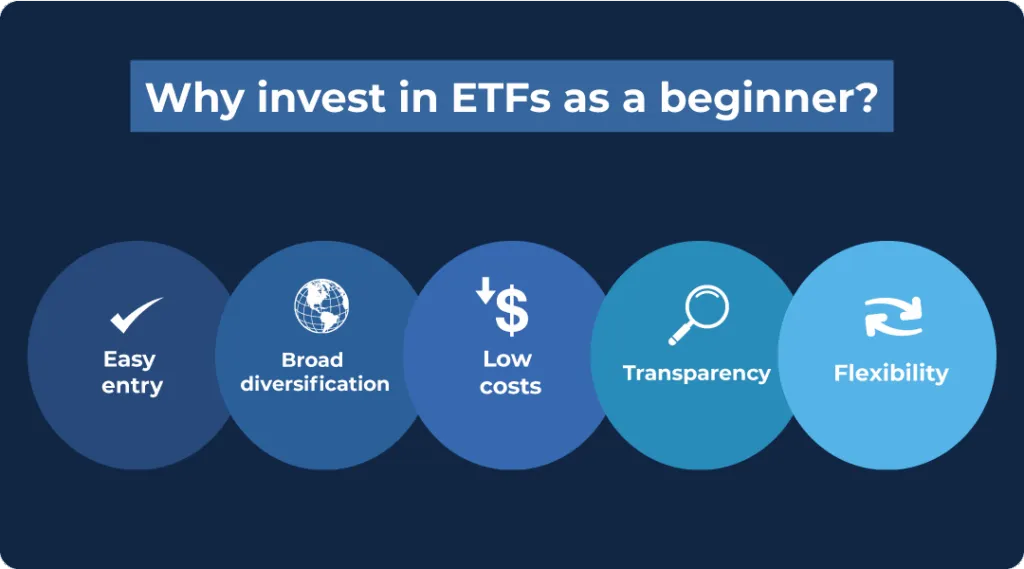Investing can feel overwhelming for beginners. Stocks go up and down every day, financial jargon can be confusing, and the risk of losing money often discourages new investors from getting started. This is where Exchange-Traded Funds (ETFs) come in.
ETFs have become one of the most popular investment vehicles in the world because they offer simplicity, diversification, and safety compared to picking individual stocks. In 2025, experts agree that ETFs are more accessible than ever before and represent one of the best entry points for new investors.
This guide will explain what ETFs are, why they’re considered safer than many other investments, and how beginners can start investing confidently.
What Exactly Is an ETF?
An Exchange-Traded Fund (ETF) is a type of investment fund that holds a basket of assets—like stocks, bonds, or commodities—and trades on the stock exchange just like individual stocks.
For example:
- A S&P 500 ETF holds shares of the 500 largest U.S. companies.
- A Technology ETF focuses on companies in the tech sector.
- A Bond ETF invests in fixed-income securities.
By purchasing a single ETF, you’re instantly diversifying across dozens or even hundreds of companies, which spreads out your risk.
Why ETFs Are Safer for Beginners
Many beginners wonder: Are ETFs really safer than stocks? The short answer is yes—when used correctly. Here’s why:
1. Built-in Diversification
Instead of buying one company’s stock, ETFs allow you to invest in many at once. If one company underperforms, the others in the fund can help balance things out.
2. Lower Risk of Total Loss
If you put all your money in one stock and that company fails, you could lose everything. With ETFs, even if one or two companies struggle, the rest of the fund helps protect your investment.
3. Professional Management
Most ETFs are designed to track an index or sector, meaning they’re structured and managed by professionals. This reduces the need for constant monitoring on your part.
4. Cost-Effective
ETFs usually have lower fees compared to mutual funds. For beginners, this means more of your money is actually invested rather than lost to high management costs.
5. Easy to Buy and Sell
Like stocks, ETFs can be bought or sold anytime during trading hours. This gives you flexibility and liquidity compared to other long-term investments.
Types of ETFs Beginners Should Know
There are thousands of ETFs available, but not all are beginner-friendly. Here are some categories to understand:
- Index ETFs – Track a market index like the S&P 500. (Great for beginners.)
- Bond ETFs – Invest in government or corporate bonds. (Lower risk.)
- Sector ETFs – Focus on a specific industry like technology or healthcare.
- International ETFs – Provide exposure to global markets.
- Dividend ETFs – Focus on companies that pay regular dividends.
For most beginners, broad market index ETFs are the safest and simplest choice.
How to Start Investing in ETFs
Getting started is easier than you think. Follow these steps:
Step 1: Choose a Reliable Brokerage
Pick a brokerage platform that offers zero-commission trades and easy-to-use tools. Many platforms now allow beginners to start with small amounts.
Step 2: Define Your Goals
Are you investing for retirement, a big purchase, or general wealth-building? Your goal will determine what type of ETFs to choose.
Step 3: Start Small
You don’t need thousands of dollars. Many brokerages allow fractional ETF shares, meaning you can start with as little as $10–$50.
Step 4: Use Dollar-Cost Averaging
Instead of investing a lump sum, invest a fixed amount regularly (e.g., $100 every month). This smooths out market ups and downs.
Step 5: Hold for the Long Term
ETFs are most powerful when held for years. The longer you invest, the more time your money has to grow.
Common Mistakes to Avoid When Investing in ETFs
Even though ETFs are beginner-friendly, there are mistakes to watch out for:
- Chasing Trends – Don’t just buy ETFs because they’re popular. Stick to your goals.
- Ignoring Fees – Even small fees can eat into profits over time. Look for ETFs with low expense ratios.
- Over-Diversifying – Buying too many ETFs can reduce potential gains. Stick to a few broad ones.
- Selling Too Early – Market dips happen. Don’t panic-sell—ETFs are built for the long term.
Real-World Example of ETF Safety
Imagine two investors:
- Investor A buys $5,000 worth of a single tech stock. If the company drops 40%, the portfolio loses $2,000.
- Investor B puts $5,000 into a technology ETF containing 50 companies. If one company falls 40%, the impact is much smaller because the other 49 companies help balance the loss.
This is the power of diversification—and the main reason ETFs are safer than individual stocks.
Frequently Asked Questions (FAQs)
1. Are ETFs risk-free?
No investment is risk-free. ETFs reduce risk compared to single stocks but still fluctuate with the market.
2. How much money do I need to start investing in ETFs?
Some brokerages allow you to start with as little as $10 using fractional shares.
3. Can ETFs make me rich?
ETFs are designed for steady, long-term growth—not quick profits. They’re ideal for building wealth over time.
4. What’s the difference between ETFs and mutual funds?
ETFs trade like stocks and usually have lower fees, while mutual funds are priced once per day and often come with higher costs.
5. Which ETF is best for beginners?
Broad index ETFs, like those tracking the S&P 500 or total stock market, are considered the safest starting point.
6. Do ETFs pay dividends?
Yes, many ETFs distribute dividends from the companies they hold. These can be reinvested to grow your wealth faster.
Conclusion
For beginners, ETFs offer one of the safest, simplest, and most effective ways to start investing. They provide diversification, lower risk, and easy access to entire markets with just one purchase. While no investment is completely risk-free, ETFs strike the perfect balance between safety and growth potential.
If you’re new to investing in 2025, starting with ETFs can help you build a strong financial foundation without the stress of picking individual stocks.


